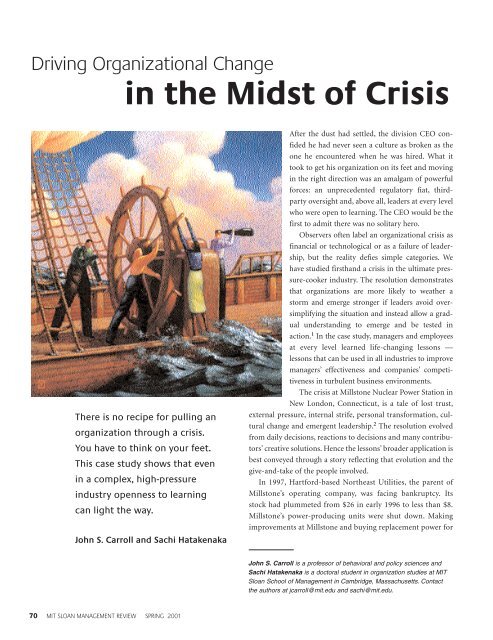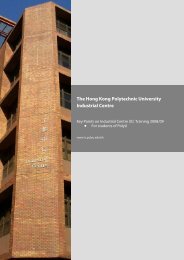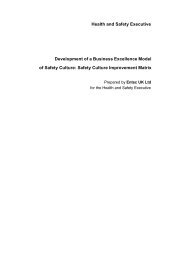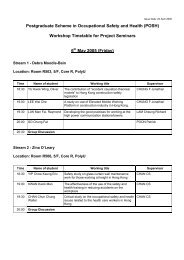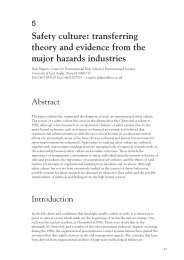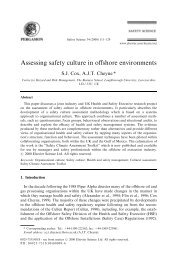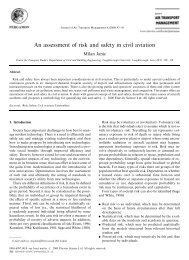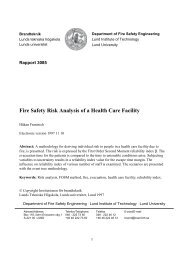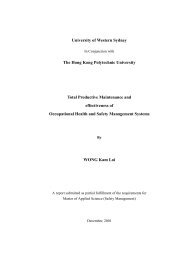Driving Organizational Change in the Midst of Crisis
Driving Organizational Change in the Midst of Crisis
Driving Organizational Change in the Midst of Crisis
- No tags were found...
You also want an ePaper? Increase the reach of your titles
YUMPU automatically turns print PDFs into web optimized ePapers that Google loves.
<strong>Driv<strong>in</strong>g</strong> <strong>Organizational</strong> <strong>Change</strong><strong>in</strong> <strong>the</strong> <strong>Midst</strong> <strong>of</strong> <strong>Crisis</strong>There is no recipe for pull<strong>in</strong>g anorganization through a crisis.You have to th<strong>in</strong>k on your feet.This case study shows that even<strong>in</strong> a complex, high-pressure<strong>in</strong>dustry openness to learn<strong>in</strong>gcan light <strong>the</strong> way.John S. Carroll and Sachi HatakenakaAfter <strong>the</strong> dust had settled, <strong>the</strong> division CEO confidedhe had never seen a culture as broken as <strong>the</strong>one he encountered when he was hired. What ittook to get his organization on its feet and mov<strong>in</strong>g<strong>in</strong> <strong>the</strong> right direction was an amalgam <strong>of</strong> powerfulforces: an unprecedented regulatory fiat, thirdpartyoversight and, above all, leaders at every levelwho were open to learn<strong>in</strong>g. The CEO would be <strong>the</strong>first to admit <strong>the</strong>re was no solitary hero.Observers <strong>of</strong>ten label an organizational crisis asf<strong>in</strong>ancial or technological or as a failure <strong>of</strong> leadership,but <strong>the</strong> reality defies simple categories. Wehave studied firsthand a crisis <strong>in</strong> <strong>the</strong> ultimate pressure-cooker<strong>in</strong>dustry. The resolution demonstratesthat organizations are more likely to wea<strong>the</strong>r astorm and emerge stronger if leaders avoid oversimplify<strong>in</strong>g<strong>the</strong> situation and <strong>in</strong>stead allow a gradualunderstand<strong>in</strong>g to emerge and be tested <strong>in</strong>action. 1 In <strong>the</strong> case study, managers and employeesat every level learned life-chang<strong>in</strong>g lessons —lessons that can be used <strong>in</strong> all <strong>in</strong>dustries to improvemanagers’ effectiveness and companies’ competitiveness<strong>in</strong> turbulent bus<strong>in</strong>ess environments.The crisis at Millstone Nuclear Power Station <strong>in</strong>New London, Connecticut, is a tale <strong>of</strong> lost trust,external pressure, <strong>in</strong>ternal strife, personal transformation, culturalchange and emergent leadership. 2 The resolution evolvedfrom daily decisions, reactions to decisions and many contributors’creative solutions. Hence <strong>the</strong> lessons’ broader application isbest conveyed through a story reflect<strong>in</strong>g that evolution and <strong>the</strong>give-and-take <strong>of</strong> <strong>the</strong> people <strong>in</strong>volved.In 1997, Hartford-based Nor<strong>the</strong>ast Utilities, <strong>the</strong> parent <strong>of</strong>Millstone’s operat<strong>in</strong>g company, was fac<strong>in</strong>g bankruptcy. Itsstock had plummeted from $26 <strong>in</strong> early 1996 to less than $8.Millstone’s power-produc<strong>in</strong>g units were shut down. Mak<strong>in</strong>gimprovements at Millstone and buy<strong>in</strong>g replacement power forJohn S. Carroll is a pr<strong>of</strong>essor <strong>of</strong> behavioral and policy sciences andSachi Hatakenaka is a doctoral student <strong>in</strong> organization studies at MITSloan School <strong>of</strong> Management <strong>in</strong> Cambridge, Massachusetts. Contact<strong>the</strong> authors at jcarroll@mit.edu and sachi@mit.edu.70 MIT SLOAN MANAGEMENT REVIEW SPRING 2001
Timel<strong>in</strong>eIndustryLeader1980sKeyCostConcernsECP = Employee-Concerns ProgramECOP = Employee-Concerns Oversight PanelSCWE = Safety-Conscious Work EnvironmentERB = Executive Review BoardHR = Human ResourcesThe higher <strong>the</strong> timel<strong>in</strong>e goes, <strong>the</strong>healthier Millstone is. The width <strong>of</strong> <strong>the</strong>timel<strong>in</strong>e represents <strong>the</strong> extent to whichsafety-consciousness was embedded <strong>in</strong>company activities.Dave Amer<strong>in</strong>eReshapesPeople TeamEmployeeSupportGroupUnit 3BuiltInternalAllegations1991–1995TimeMagaz<strong>in</strong>eArticleNRCOrder1996BruceKenyonArrivesRebuildECPMike Bro<strong>the</strong>rsTakes OverSCWEECOPCreatedLittleHarborConsults1997Tra<strong>in</strong><strong>in</strong>g& Fir<strong>in</strong>gEventsExplicitMeasures<strong>of</strong> ResultsERBSet Up1998Rebuild HRManagementTra<strong>in</strong><strong>in</strong>gRestartUnit 3Timebecame more capable <strong>of</strong> learn<strong>in</strong>g. They saw <strong>the</strong>y had to cooperatefor <strong>the</strong> good <strong>of</strong> all.As director <strong>of</strong> <strong>the</strong> employee-concerns program, Ed Morganmoved rapidly. He categorized employee concerns, lowered <strong>the</strong>threshold for what could be reported, and set high standards fordo<strong>in</strong>g <strong>the</strong> work. The low threshold elicited issues from contractors,whose problems <strong>of</strong>ten stemmed from not understand<strong>in</strong>g<strong>the</strong> plant. If a supervisor lost patience and said someth<strong>in</strong>g <strong>in</strong>appropriatesuch as, “This is a no-bra<strong>in</strong>er,” <strong>the</strong> upset contractorwould accuse <strong>the</strong> supervisor <strong>of</strong> <strong>in</strong>timidation. “Millstone lost keypeople who left under that k<strong>in</strong>d <strong>of</strong> pressure,” an <strong>in</strong>tervieweetold us. Fortunately, Morgan had <strong>the</strong> ability to see both sides —to understand how both parties could become victims.Br<strong>in</strong>g<strong>in</strong>g <strong>in</strong> a Third-Party, External Oversight TeamIn January 1997, Nor<strong>the</strong>ast Nuclear Energy nom<strong>in</strong>ated LittleHarbor Consultants as its <strong>in</strong>dependent third-party oversightteam. At <strong>the</strong> urg<strong>in</strong>g <strong>of</strong> Dave Goebel and Bruce Kenyon, an attorneynamed Billie Garde was added to <strong>the</strong> team because <strong>of</strong> herexperience as an employee advocate and as a facilitator for <strong>the</strong>embroiled employee-concerns task force.Little Harbor gave <strong>the</strong> NRC, <strong>in</strong> <strong>the</strong> words <strong>of</strong> one <strong>in</strong>terviewee, “ahuge benefit at almost no cost.”It monitored <strong>the</strong> work environmentand developed <strong>the</strong> list <strong>of</strong> components <strong>of</strong> an ideal safety-consciouswork environment. The list addressed senior-management policies,tra<strong>in</strong><strong>in</strong>g for all managers on handl<strong>in</strong>g safety compla<strong>in</strong>ts, <strong>the</strong> importance<strong>of</strong> employee perception <strong>of</strong> <strong>the</strong> policy and its implementation,an employee-concerns program to handle issues separate from <strong>the</strong>l<strong>in</strong>e organization, and periodic <strong>in</strong>dependent assessments and selfassessmentsto monitor and improve performance. 10 Over time,Little Harbor began to work more closely with management. As an<strong>in</strong>terviewee from <strong>the</strong> NRC said, “Little Harbor operated <strong>in</strong> ways wedidn’t imag<strong>in</strong>e. … We expected <strong>the</strong>m to monitor. … They becamemore proactive <strong>in</strong> assist<strong>in</strong>g with thoughts [and] suggestions.”Engag<strong>in</strong>g <strong>the</strong> L<strong>in</strong>e ManagersIn April 1997, a Safety-Conscious Work Environment <strong>in</strong>itiativewas established to broaden <strong>the</strong> change process. As one <strong>in</strong>tervieweeexpla<strong>in</strong>ed, “Ed Morgan could build an effective[employee-concerns program], but only <strong>the</strong> l<strong>in</strong>e organizationcould develop a healthy work environment.”Kenyon announced that vice president for operationsMike Bro<strong>the</strong>rs would head <strong>the</strong> <strong>in</strong>itiative, surpris<strong>in</strong>g employeeswho foresaw a fox <strong>in</strong> <strong>the</strong> henhouse. Like most <strong>of</strong> <strong>the</strong>operations group, Bro<strong>the</strong>rs had come from <strong>the</strong> nuclear Navy.He described its culture <strong>in</strong> an <strong>in</strong>terview as “locker room teas<strong>in</strong>g.… People are verbally brutal to each o<strong>the</strong>r and develop atough shell.” At Millstone, “A lot <strong>of</strong> people were scared <strong>of</strong>SPRING 2001 MIT SLOAN MANAGEMENT REVIEW 73
me,” he admitted. “I didn’t realize <strong>the</strong> power <strong>of</strong> perceptions.”But Bro<strong>the</strong>rs’ emergence as <strong>the</strong> safety-conscious workenvironmentleader gave <strong>the</strong> effort <strong>in</strong>ternal authority. He setup a group to f<strong>in</strong>d problem areas and formalize plans to dealwith <strong>the</strong>m. The group began to teach l<strong>in</strong>e managers what wasmeant by a safety-conscious work environment, how to workwith employees and how to communicate better.Leadership tra<strong>in</strong><strong>in</strong>g started <strong>in</strong> May, with help from BillieGarde and Little Harbor. The feedback from <strong>the</strong> sessionswas that more tra<strong>in</strong><strong>in</strong>g was needed. As one participantsaid, it “whetted our appetite.”Learn<strong>in</strong>g by Do<strong>in</strong>gTwo def<strong>in</strong><strong>in</strong>g experiences <strong>in</strong> summer 1997 challenged <strong>the</strong>commitment and resources <strong>of</strong> both <strong>the</strong> organization and<strong>the</strong> <strong>in</strong>dividuals <strong>in</strong>volved.Discipl<strong>in</strong><strong>in</strong>g for Past Actions First, management discipl<strong>in</strong>ed 20members <strong>of</strong> <strong>the</strong> tra<strong>in</strong><strong>in</strong>g and operations departments because<strong>of</strong> <strong>in</strong>accuracies <strong>in</strong> tra<strong>in</strong><strong>in</strong>g documentation two years earlier.The former tra<strong>in</strong><strong>in</strong>g director, an outspoken critic <strong>of</strong> currentperformance who had become nuclear-oversight director, wasamong those discipl<strong>in</strong>ed. The discipl<strong>in</strong>e triggered an uproarfrom employees who suspected retaliation for criticism <strong>of</strong>management. Although an <strong>in</strong>dependent <strong>in</strong>vestigation determ<strong>in</strong>edthat <strong>the</strong> action was generally appropriate, it was apparentthat management had failed to anticipate <strong>the</strong> potentialeffect <strong>of</strong> <strong>the</strong> discipl<strong>in</strong>e or to undertake timely communicationto m<strong>in</strong>imize <strong>the</strong> potential for a chill<strong>in</strong>g effect. 11 People’s perceptionis <strong>the</strong>ir reality.Fir<strong>in</strong>g Contractors Who Raised Safety Concerns Second, contractormanagement fired two contractors for alleged poor performance,with <strong>the</strong> approval <strong>of</strong> several layers <strong>of</strong> Millstone management.The two contractors had raised safety concerns about <strong>the</strong>adequacy <strong>of</strong> <strong>the</strong> work <strong>the</strong> contractor group was do<strong>in</strong>g on animportant project. Bruce Kenyon <strong>in</strong>itially supported <strong>the</strong> term<strong>in</strong>ations,believ<strong>in</strong>g everyone had honest <strong>in</strong>tent. But as director <strong>of</strong><strong>the</strong> employee-concerns program, Ed Morgan moved immediatelyto get <strong>the</strong> decision overturned, and Kenyon reversed himself.The employee-concerns program’s subsequent<strong>in</strong>vestigation revealed that <strong>the</strong> term<strong>in</strong>ations were not justifiable.The employee-concerns program’s response greatly enhancedthat group’s credibility with <strong>the</strong> work force.Initially, Mike Bro<strong>the</strong>rs, <strong>the</strong> head <strong>of</strong> <strong>the</strong> safety-conscious workenvironment, was just “go<strong>in</strong>g through <strong>the</strong> motions,” he admits. “Ididn’t believe anyone would harass someone who brought forthsafety concerns.” But Bro<strong>the</strong>rs says he changed after he heard EdMorgan and <strong>the</strong> employee-concerns <strong>in</strong>vestigator give LittleHarbor <strong>the</strong>ir view on <strong>the</strong> term<strong>in</strong>ations. “It was one <strong>of</strong> thosemoments your perception changes. ... [There was] clear-cutharassment. ... [It was] a watershed for me.” Bro<strong>the</strong>rs immediatelyput <strong>the</strong> term<strong>in</strong>ated contractors on reta<strong>in</strong>er while <strong>the</strong> case was<strong>in</strong>vestigated, and a week later both were <strong>of</strong>fered back <strong>the</strong>ir jobs.The executive review board <strong>in</strong>creased employees’trust <strong>in</strong> management. It brought toge<strong>the</strong>r multipleperspectives to create a learn<strong>in</strong>g environment andto help board members and managers th<strong>in</strong>k through<strong>the</strong>ir decisions.Extensive management discussion follow<strong>in</strong>g <strong>the</strong> contractorfir<strong>in</strong>gs, comb<strong>in</strong>ed with <strong>in</strong>creas<strong>in</strong>g <strong>in</strong>tervention from LittleHarbor, led to <strong>the</strong> creation <strong>of</strong> an executive board to review alldiscipl<strong>in</strong>ary action from written reprimand to term<strong>in</strong>ation. 12Eventually, reviews were extended to cover not only employeesbut contractors, too. Over time, <strong>the</strong> executive review board<strong>in</strong>creased employees’ trust <strong>in</strong> management. It brought toge<strong>the</strong>rmultiple perspectives to create a learn<strong>in</strong>g environment and tohelp both board members and managers who presented <strong>the</strong>ircases th<strong>in</strong>k through <strong>the</strong>ir decisions and manage <strong>the</strong>ir organizations.Managers began to ask <strong>the</strong> executive review board foradvice even before tak<strong>in</strong>g personnel actions.Institutionaliz<strong>in</strong>g a Safety-Conscious Work EnvironmentMillstone’s recovery was <strong>in</strong> high gear by fall 1997, but it was stilla patchwork <strong>of</strong> efforts. For change to become embedded organizationwide,Millstone needed changes <strong>in</strong> attitudes and behaviors— and formal structures to susta<strong>in</strong> <strong>the</strong> new culture. Keypeople concentrat<strong>in</strong>g on <strong>the</strong> safety-conscious work-environment<strong>in</strong>itiative were needed elsewhere. The <strong>in</strong>itiative had tobecome an everyday practice <strong>of</strong> all l<strong>in</strong>e managers and draw onemergent leaders.Build<strong>in</strong>g Supportive Structures In November 1997, Dave Amer<strong>in</strong>e,newly hired to head <strong>the</strong> nuclear eng<strong>in</strong>eer<strong>in</strong>g and supportdepartment, volunteered to become vice president <strong>of</strong> humanresources and be responsible for <strong>the</strong> safety-conscious workenvironment<strong>in</strong>itiative. Mike Bro<strong>the</strong>rs <strong>the</strong>n could focus onmanag<strong>in</strong>g <strong>the</strong> long lists <strong>of</strong> physical and paper changes neededfor <strong>the</strong> restart <strong>of</strong> unit three. Amer<strong>in</strong>e, accord<strong>in</strong>g to one <strong>in</strong>dividual,was “an eng<strong>in</strong>eer par excellence [and] <strong>the</strong> least right-bra<strong>in</strong>74 MIT SLOAN MANAGEMENT REVIEW SPRING 2001
and <strong>the</strong> responses to <strong>in</strong>dividual compla<strong>in</strong>ts filed with <strong>the</strong>employee-concerns program. The learn<strong>in</strong>g was not <strong>in</strong> <strong>the</strong> policyand <strong>the</strong> structures but <strong>in</strong> <strong>the</strong> behaviors that made <strong>the</strong> structurescome to life. The safety-conscious work-environment conceptbecame part <strong>of</strong> senior managers’ personal learn<strong>in</strong>g.Dur<strong>in</strong>g our <strong>in</strong>terviews, <strong>the</strong> <strong>the</strong>me arose repeatedly that work<strong>in</strong>gon change changed everyone. People became what <strong>the</strong>yneeded to be. They found support <strong>in</strong> a system that encouraged<strong>the</strong>m to acknowledge problems and work toge<strong>the</strong>r. The challengeschanged both managers and employees. Skeptical employeeswatched to see how management reacted to def<strong>in</strong><strong>in</strong>g moments;<strong>the</strong>y weighed <strong>the</strong> differences between words and deeds, betweenpaper promises and real change. Their evaluations would determ<strong>in</strong>eMillstone’s success or failure. The <strong>in</strong>itial tests were necessarynear-failures, but management admitted its mistakes, kept <strong>the</strong>l<strong>in</strong>es <strong>of</strong> communication open, sought lessons for improvementand help from more participants, and tried aga<strong>in</strong>. Over time, peoplelearned to deal with chronic problems, and <strong>the</strong>y learned <strong>the</strong>ywere capable <strong>of</strong> change and that change was welcome.New Ways <strong>of</strong> Th<strong>in</strong>k<strong>in</strong>g About People Much <strong>of</strong> <strong>the</strong> learn<strong>in</strong>g atMillstone required a new sensitivity toward emotions, perceptionsand relationships. Like many <strong>in</strong>dustries, nuclear powerattracts and rewards people who have technical skills and getth<strong>in</strong>gs done — who are objective and leave <strong>the</strong>ir feel<strong>in</strong>gs outside.Few Millstone managers understood how <strong>the</strong>y had lost <strong>the</strong>trust <strong>of</strong> <strong>the</strong> work force or what would be needed to br<strong>in</strong>g heal<strong>in</strong>g.With help from outside consultants and <strong>in</strong>siders with some<strong>of</strong> <strong>the</strong> requisite skills, managers learned that guess<strong>in</strong>g what peopleth<strong>in</strong>k by pretend<strong>in</strong>g to be <strong>in</strong> <strong>the</strong>ir shoes is less effective thangett<strong>in</strong>g people to express <strong>the</strong>mselves. When <strong>the</strong>y express <strong>the</strong>mselvesand get a respectful reception, <strong>the</strong> result is communicationand heal<strong>in</strong>g. Employees must have a reason to believe thatmanagement wants to listen, wants to respond appropriately,respects employees’ suggestions and has <strong>the</strong> competence to succeed.The most powerful way to rega<strong>in</strong> trust is to work toge<strong>the</strong>rwith a common purpose. 21The journey is not over. Millstone, like <strong>the</strong> rest <strong>of</strong> <strong>the</strong>nuclear-power <strong>in</strong>dustry, faces serious challenges. Past mistrustand feel<strong>in</strong>gs <strong>of</strong> anger and hurt can be stirred up by new situations.The work environment and <strong>the</strong> performance successesare fragile, and many people have given about all <strong>the</strong>y can.There will be crises to be avoided and crises to be used to mobilizeenergy for change. Many <strong>in</strong>dustries face challenges <strong>of</strong> rapidchange, ambiguous <strong>in</strong>ternal and external signals, alienation andmistrust, and dysfunctional human relationships. But people <strong>in</strong>all work sett<strong>in</strong>gs can learn from <strong>the</strong> journey out <strong>of</strong> crisis, a journeythat, like learn<strong>in</strong>g itself, never ends.ACKNOWLEDGMENTSThe authors are grateful for <strong>the</strong> cooperation and candor <strong>of</strong> Bruce Kenyon and <strong>the</strong>o<strong>the</strong>r <strong>in</strong>terviewees, who understood <strong>the</strong> importance <strong>of</strong> shar<strong>in</strong>g Millstone’s lessons.The research was supported by a Marv<strong>in</strong> Bower Fellowship at <strong>the</strong> HarvardBus<strong>in</strong>ess School.ADDITIONAL RESOURCESEd Sche<strong>in</strong>’s 1999 book “The Corporate Culture Survival Guide” (from Jossey-Bass <strong>in</strong>San Francisco) <strong>of</strong>fers thoughtful and practical advice. Two <strong>in</strong>terest<strong>in</strong>g examples <strong>of</strong>senior managers reshap<strong>in</strong>g <strong>the</strong>ir companies are seen <strong>in</strong> David Kearns and DavidNadler’s description <strong>of</strong> Xerox <strong>in</strong> “Prophets <strong>in</strong> <strong>the</strong> Dark” (from HarperColl<strong>in</strong>s <strong>in</strong> NewYork, 1992) and <strong>in</strong> Noel Tichy and Stratford Sherman’s story <strong>of</strong> Jack Welch at GeneralElectric <strong>in</strong> “Control Your Dest<strong>in</strong>y or Someone Else Will” (a 1993 Doubleday book).REFERENCES1. C. Argyris, “Knowledge for Action: A Guide to Overcom<strong>in</strong>g Barriers to<strong>Organizational</strong> <strong>Change</strong>” (San Francisco: Jossey-Bass, 1993); and K.E.Weick, “Sensemak<strong>in</strong>g <strong>in</strong> Organizations” (Thousand Oaks, California:Sage, 1995).2. The first author was on <strong>the</strong> Nuclear Committee Advisory Team, report<strong>in</strong>gto <strong>the</strong> Nuclear Committee <strong>of</strong> <strong>the</strong> Board <strong>of</strong> Trustees <strong>of</strong> Nor<strong>the</strong>astUtilities. From its beg<strong>in</strong>n<strong>in</strong>g <strong>in</strong> 1996 to its term<strong>in</strong>ation <strong>in</strong> 2000, he metregularly with staff responsible for employee concerns and <strong>the</strong> safetyconsciouswork environment, observed meet<strong>in</strong>gs and read documents.Also, <strong>the</strong> authors conducted 18 <strong>in</strong>terviews with key people from Nor<strong>the</strong>astUtilities companies, Millstone, <strong>the</strong> U.S. Nuclear Regulatory Commissionand <strong>the</strong> Nuclear Energy Institute, an <strong>in</strong>dustry lobby<strong>in</strong>g group.3. U.S. Nuclear Regulatory Commission, “Annual Report, 1994-FY 95,Office for Analysis and Evaluation <strong>of</strong> Operational Data, NUREG-1272”(Wash<strong>in</strong>gton, D.C.: U.S. Nuclear Regulatory Commission, 1996).4. E. Pooley, “Nuclear Warriors,” Time, March 4, 1996, 46-54.5. J.N. Hannon, et al., “Millstone Independent Review Group, Handl<strong>in</strong>g<strong>of</strong> Employee Concerns and Allegations at Millstone Nuclear PowerStation Units 1, 2, & 3 from 1985-Present” (Wash<strong>in</strong>gton, D.C.: U.S.Nuclear Regulatory Commission, Oct. 24, 1996).6. F.J. Miraglia, “Order Requir<strong>in</strong>g Independent, Third-Party Oversight <strong>of</strong>Nor<strong>the</strong>ast Nuclear Energy Company’s Implementation <strong>of</strong> Resolution <strong>of</strong>Millstone Station Employee Safety Concerns” (Wash<strong>in</strong>gton, D.C.: U.S.Nuclear Regulatory Commission, Oct. 24, 1996).7. Some commissioners believe <strong>the</strong> NRC overreacted to Millstone. SeeN.J. Diaz, “Comments <strong>of</strong> Commissioner Diaz on SECY-98-119”(Wash<strong>in</strong>gton, D.C.: U.S. Nuclear Regulatory Commission, June 11, 1998).8. For example, several key contributors now work at Alyeska, <strong>the</strong>Alaska oil pipel<strong>in</strong>e company. Many have accepted <strong>in</strong>vitations to speakto o<strong>the</strong>r organizations. See D. Amer<strong>in</strong>e, “Establish<strong>in</strong>g a SafetyConscious Work Environment” (presentation at <strong>the</strong> U.S. Department <strong>of</strong>Energy Hanford site, Richland, Wash<strong>in</strong>gton, March 25, 1999). The specialfeautres <strong>of</strong> high-hazard work systems are described <strong>in</strong> T.R. LaPorteand P.M. Consol<strong>in</strong>i, “Work<strong>in</strong>g <strong>in</strong> Practice but Not <strong>in</strong> Theory: TheoreticalChallenges <strong>of</strong> ‘High-Reliability Organizations,’ ” Journal <strong>of</strong> PublicAdm<strong>in</strong>istration and Research 1, no. 1 (w<strong>in</strong>ter 1991): 19-47; C. Perrow,“Normal Accidents: Liv<strong>in</strong>g With High Risk Technologies” (New York:Basic Books, 1984); J. Reason, “Manag<strong>in</strong>g <strong>the</strong> Risks <strong>of</strong> <strong>Organizational</strong>Accidents” (Brookfield, Vermont: Ashgate, 1997); and K.E. Weick, K.M.Sutcliffe and D. Obstfeld, “Organiz<strong>in</strong>g for High Reliability: Processes <strong>of</strong>Collective M<strong>in</strong>dfulness,” Research <strong>in</strong> <strong>Organizational</strong> Behavior 21(1999): 81-123.78 MIT SLOAN MANAGEMENT REVIEW SPRING 2001
9. Quotations come from our <strong>in</strong>terviews.10. J.W. Beck, J.M. Griff<strong>in</strong> and B.P. Garde, “Independent Oversight <strong>of</strong><strong>the</strong> Safety Conscious Work Environment at <strong>the</strong> Nor<strong>the</strong>ast UtilitiesMillstone Site” (presentation at <strong>the</strong> American Nuclear SocietyInternational Topical Meet<strong>in</strong>g on Safety <strong>of</strong> Operat<strong>in</strong>g Reactors, SanFrancisco, Oct. 11-14, 1998); and Little Harbor Consultants Inc.,“Oversight Plan, Independent Third Party Oversight Program (ITPOP),revision 2” (Cohasset, Massachusetts: Little Harbor Consultants, 1998).11. A chill<strong>in</strong>g effect refers to employees’ suppress<strong>in</strong>g <strong>the</strong>ir compla<strong>in</strong>tsbecause <strong>the</strong>y perceive that <strong>the</strong>ir concerns will be met with retaliation.12. The board consisted <strong>of</strong> <strong>the</strong> leader <strong>of</strong> <strong>the</strong> safety-conscious workenvironment <strong>in</strong>itiative, <strong>the</strong> director <strong>of</strong> human resources and a representativefrom <strong>the</strong> legal-contracts area, with <strong>the</strong> manager <strong>of</strong> <strong>the</strong> employeeconcernsoversight panel <strong>in</strong> attendance.13. Trust <strong>in</strong> <strong>the</strong> <strong>in</strong>tentions vs. <strong>the</strong> competence <strong>of</strong> management differ.See A.C. Edmondson and B. Mo<strong>in</strong>geon, “Learn<strong>in</strong>g, Trust and<strong>Organizational</strong> <strong>Change</strong>: Contrast<strong>in</strong>g Models <strong>of</strong> Intervention Research <strong>in</strong><strong>Organizational</strong> Behaviour,” <strong>in</strong> “<strong>Organizational</strong> Learn<strong>in</strong>g and <strong>the</strong> Learn<strong>in</strong>gOrganization,” eds. M. Easterby-Smith, J. Burgoyne and L. Araujo(Thousand Oaks, California: Sage, 1999), 157-175.14. True <strong>of</strong> many <strong>in</strong>dustries. See A.C. Edmondson, “Learn<strong>in</strong>g FromMistakes Is Easier Said Than Done: Group and <strong>Organizational</strong>Influences on <strong>the</strong> Detection and Correction <strong>of</strong> Human Error,” Journal <strong>of</strong>Applied Behavioral Science 32, no. 1 (March 1996): 5-28; and D.N.Michael, “On Learn<strong>in</strong>g To Plan and Plann<strong>in</strong>g To Learn” (San Francisco:Jossey-Bass, 1976).15. Little Harbor Consultants Inc., “Assessment <strong>of</strong> Millstone SafetyConscious Work Environment Performed June 21-July 1, 1999”(Cohasset, Massachusetts: Little Harbor Consultants, 1999).16. R.M. Kanter, B. Ste<strong>in</strong> and T. Jick, “The Challenge <strong>of</strong> <strong>Organizational</strong><strong>Change</strong>: How Companies Experience It and Leaders Guide It” (NewYork: Free Press, 1992); J.P. Kotter, “Lead<strong>in</strong>g <strong>Change</strong>” (Boston:Harvard Bus<strong>in</strong>ess School Press, 1996).17. M. Beer and R.A. Eisenstat, “The Silent Killers <strong>of</strong> StrategyImplementation and Learn<strong>in</strong>g,” Sloan Management Review 41, no. 4(summer 2000): 29-40; and J. Gabarro, “The Dynamics <strong>of</strong> Tak<strong>in</strong>gCharge” (Boston: Harvard Bus<strong>in</strong>ess School Press, 1987).18. D.A. Nadler, R.B. Shaw, A.E. Walton and associates, “Discont<strong>in</strong>uous<strong>Change</strong>: Lead<strong>in</strong>g <strong>Organizational</strong> Transformation” (San Francisco:Jossey-Bass, 1995); E.H. Sche<strong>in</strong>, “<strong>Organizational</strong> Culture andLeadership” (San Francisco: Jossey-Bass, 1992); and P.M. Senge,“Lead<strong>in</strong>g Learn<strong>in</strong>g Organizations: The Bold, <strong>the</strong> Powerful, and <strong>the</strong>Invisible,” <strong>in</strong> “The Leader <strong>of</strong> <strong>the</strong> Future,” eds. F. Hesselbe<strong>in</strong>, M.Goldsmith and R. Beckhard (San Francisco: Jossey-Bass, 1996), 41-57.19. P.R. Schulman, “The Negotiated Order <strong>of</strong> <strong>Organizational</strong> Reliability,”Adm<strong>in</strong>istration and Society 25 (November 1993): 353-372. There wereimportant visits to South Texas Project, a nuclear power plant that hademerged from crisis as an <strong>in</strong>dustry leader. Nilsson Associates hadworked <strong>the</strong>re.20. C. Argyris, R. Putnam and D.M. Smith, “Action Science: Concepts,Methods and Skills for Research and Intervention” (San Francisco:Jossey-Bass, 1985).21. R.M. Kramer, “Trust and Distrust <strong>in</strong> Organizations: Emerg<strong>in</strong>gPerspectives, Endur<strong>in</strong>g Questions,” Annual Review <strong>of</strong> Psychology 50(1999): 569-598; and E.M. Whitener, S.E. Brodt, M.A. Korsgaard andJ.M. Werner, “Managers as Initiators <strong>of</strong> Trust: An Exchange RelationshipFramework for Understand<strong>in</strong>g Managerial Trustworthy Behavior,”Academy <strong>of</strong> Management Review 23, no. 3 (July 1998): 513-530.Repr<strong>in</strong>t 4236Copyright ©2001 by <strong>the</strong> Sloan Management Review Association. All rights reserved.SPRING 2001 MIT SLOAN MANAGEMENT REVIEW 79
AD page


